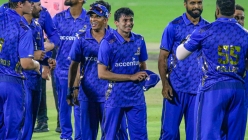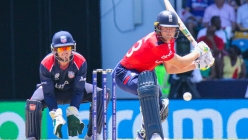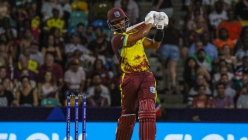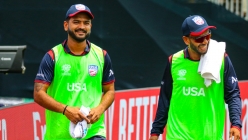Views
USA Cricket: 2019 WCL Division 2 Report Card Part 1 – Team Grades
2019 May 01 by DreamCricket USA
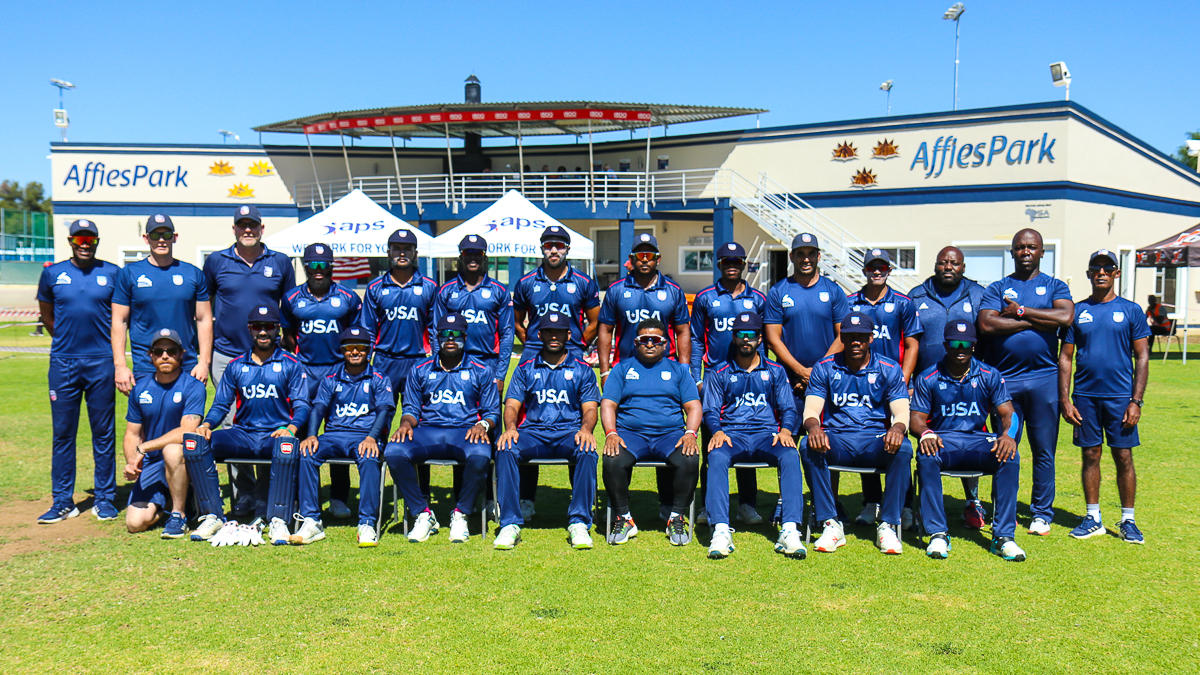
By Peter Della PennaIn Part 1 of DreamCricket's review of USA's tour to Namibia for 2019 World Cricket League Division Two, team grades are given out in the categories of batting, bowling, fielding and fitness.
Batting grade: B-
USA had the second best scoring rate in the tournament behind champions Namibia. Likewise, USA’s eight 50+ scores (two centuries, six half-centuries) was second-best in the tournament behind Namibia. Not since 2016 WCL Division Four (Steven Taylor and Alex Amsterdam) has USA had multiple batsmen score centuries in the same WCL tournament, which Aaron Jones and Xavier Marshall accomplished in Namibia in a pair of victories.
On a partnership basis, USA only had five stands of 50 or more which was tied for third in the event with Oman and Papua New Guinea. However, three of those partnerships were century stands, second only to Namibia’s four.
Out of those century stands, two of them were USA record stands: Steven Taylor and Xavier Marshall’s 184 for the second-wicket against Hong Kong broke a record that stood for more than 12 years when Steve Massiah and Sushil Nadkarni added 168 for the second wicket against a World Cup bound Bermuda team in 2006. Aaron Jones and Hayden Walsh Jr added 127 for the fourth wicket against Namibia, which equaled the fourth-wicket partnership record established by Fahad Babar and Akeem Dodson in the 2016 Auty Cup against Canada in Los Angeles.
However, USA’s batting crumbled badly on several occasions. The worst instance was in the tournament opener against Oman when they were bowled out for 148 in 37.5 overs. Another 20 runs, which was achievable had USA batted out all 50 overs, most likely would have been enough on a day where the pitch offered inconsistent bounce and the outfield was horrendous at United CC.
Similarly in the third place playoff against Papua New Guinea, the tail lacked application to stick around with Timil Patel, who ended not out on 50 as USA was bowled out in 43.4 overs for 164. The loss to Canada was an altogether different kind of collapse, but one in which USA threw away a very advantageous position needing 137 off 129 balls with eight wickets in hand but began a slide sparked by the needless runout of Taylor after he got into a mixup with Jaskaran Malhotra.
On the topic of runouts, USA’s running between the wickets on the whole was much sharper than in previous WCL tournaments. They only had four runouts the entire week. One was a freak deflection onto the stumps by Oman’s Bilal Khan in his follow-through to dismiss Xavier Marshall in the opener and Timil Patel was runout off the final of the innings against Namibia trying to steal a bye, neither of which can really be put down to bad running.
However, the two runouts in the Canada match – Monank Patel and Taylor – were absolutely atrocious sequences of cricket. On a Wanderers pitch which was offering almost nothing to the bowlers once the new ball lost its shine, the only way that Canada was going to make a breakthrough was if USA gifted them a runout with bad communication between the wickets. USA handed not one but two wickets on a golden platter, including the momentum shifting one of Taylor when Malhotra compounded the error of a poor call by refusing to sacrifice himself when both batsmen wound up at the striker’s end.
USA also benefitted at times from some sloppy fielding by their opponents. Monank Patel should have been runout without facing a ball in the first match against Papua New Guinea, but Lega Siaka’s free shot from midwicket in the ring missed and the result was Monank pinching the Man of the Match award from Karima Gore after adjudicators peculiarly decided Monank’s unbeaten 70 was more valuable in a 10-wicket win on a day when USA’s bowlers, led by Gore’s 4 for 23 and Ali Khan’s three-wicket burst in the Powerplay, had played a far more valuable role in the result. A day later against Hong Kong, Xavier Marshall was dropped on 20 and then a much easier chance on 23 before going on to make a match-winning 100.
USA had three players in the top ten scorers list, the same as Namibia, though Namibia’s trio of Stephan Baard, JJ Smit and JP Kotze were all in the top five. USA’s Marshall, Taylor and Monank were 7th, 8th and 9th respectively. Aaron Jones at 14th on the tournament scorer’s list arguably played a far more important role with the bat for USA than the aforementioned three for his century against Namibia. USA’s depth shined at times though as they had six players who finished with 100 or more runs, second only to Namibia with seven.
By comparison, Hong Kong’s lack of depth is highlighted by the fact that despite having the tournament’s leading scorer in captain Anshuman Rath, only three batsmen passed 100 runs on the tournament. Likewise, Canada’s Navneet Dhaliwal and Davy Jacobs finished in the top six of the tournament runs list but only one other player reached triple figures across the six games. Unsurprisingly, the lack of production across the squad for Hong Kong and Canada saw them finish in the bottom two outside the ODI status slots.
USA’s lineup was more settled and focused overall, but the odd incident of indiscipline like the runouts against Canada and the inability to bat 50 overs against Oman were punished. They can expect to suffer similar consequences in the new Cricket World Cup ODI League against teams like Scotland and Nepal in particular, whose bowling and fielding are much more disciplined than what USA came up against in Namibia.
Bowling grade: B-
USA’s new-ball bowling was spectacular, arguably the best of any team in the tournament. The average first wicket stand allowed by USA’s bowlers was just 10.50, and the best opening partnership allowed was 25-run stand in the third place playoff by Papua New Guinea. The new-ball combo of Saurabh Netravalkar bowling maidens from one end and Ali Khan striking with wickets from the other was outstanding at heaping early pressure on the opposition. To show how effective they were statistically compared to others at making early breakthroughs, Namibia’s bowling attack limited the first-wicket stand on average to 13.83, Oman 15.10, Canada 21.67, PNG 41.60 and Hong Kong 43.16.
Likewise, USA excelled not just at getting early wickets but in tying down the early run-rate overall in the Powerplay. On average, USA’s opposition’s Powerplay runs allowed was 28.67, the best in the tournament. By comparison, Oman’s average Powerplay score conceded was 30.17, Canada 35.17 Namibia 36.83, Hong Kong 38.67, PNG 41.83.
Only Papua New Guinea took more wickets in the Powerplay than USA with 16, which included six in the first 10 overs against Oman in a must-win final day round-robin match. USA took 14 in the Powerplay, Namibia 10, Canada 8, Oman 7, Hong Kong 4. When you combine the wickets and runs conceded, no team in the tournament was more effective at restricting the flow of runs and taking wickets in the first 10 overs than USA.
USA’s change bowling options were a different story. USA conceded six 50-plus partnerships in the tournament, third most behind Canada and Hong Kong, who finished in the bottom two. All of them were middle-overs stands as USA’s first-change medium pacers and spinners consistently struggled to take wickets after new-ball breakthroughs provided by Ali Khan, who took 17 wickets on the week.
The rest of USA’s attack took 22 combined for a total of 39 wickets by USA’s bowling unit. Papua New Guinea’s bowlers took 41 wickets on the week in spite of the fact that they lost by 10 wickets to USA. Oman’s took 50, Namibia 51, Hong Kong 33 and Canada 43, meaning USA’s bowling unit was the second weakest at the event in taking wickets. Without Ali Khan, USA may have been struggling mightily to make breakthroughs in the tournament.
In terms of building pressure, USA and Oman bowled a tournament-best 23 maidens. Twelve of USA’s 23 maidens came from Saurabh Netravalkar, and nine of those were bowled in the Powerplay, highlighting how effective he was at bowling in partnership with Ali Khan, building pressure from one end to allow Khan to strike from the other. But again, USA was far less successful at building pressure by bowling in partnerships outside of the Powerplay.
Fielding grade: C+
USA missed 14 chances on the week, 12 missed catching opportunities and two missed runouts, both by Steven Taylor in the chase by Namibia. The only truly costly missed chance on the week was a tough leg side chance by Jaskaran Malhotra off Taylor’s bowling when Navneet Dhaliwal of Canada was on 72 and went on to make an unbeaten 121 as USA eventually lost the match by 40 runs.
Four of the missed chances were horrendous misjudgements by fielders unable to adjust to the windy conditions of Windhoek. Three of those were committed by Nosthush Kenjige against Hong Kong, who was on as a sub fielder and on all three occasions came in off the rope for chances at long-on only to see the ball carry with the wind over his head and bounce inside the rope before going over for four.
USA’s ground fielding was incredibly inconsistent on the week. They could get a pass for the conditions on the opening day at United CC against Oman, but on much better maintained outfields throughout the rest of the week, they were quite often seen bobbling or fumbling pickups trying to deny a second run from the boundary. It almost cost them dearly against Namibia as they regularly conceded extra runs in the final 20 overs of the chase along the ground before Ali Khan saved them with his famous 49th over triple-strike.
In the chase against Namibia, both of Taylor’s missed runout chances appeared to be the result of lack of presence of mind under pressure. In the first instance, his body momentum took him towards the stumps fielding at extra cover and he could have simply underhanded but instead wound up trying to shatter the stumps with a full-blooded overhand attempt from five yards out. In the second instance in the final over, tailender Zhivago Groenewald was several yards short at the non-striker’s end with Taylor firing at full blast from eight yards away at extra cover once again when all that was needed was a firm relay to Saurabh Netravalkar standing over the stumps. Luckily, Netravalkar bailed Taylor out on the next ball after fielding off his bowling before unfurling a simple underhand from a few yards away, which is what Taylor hadn’t done earlier. That match-clinching wicket by Netravalkar against Namibia wound up being USA’s only converted runout on the week.
USA’s ground fielding effort in particular was below what it had been during the month of March in Dubai, when the scorecards were flooded with runouts by Hayden Walsh Jr. As has been the case over the last decade, there is still plenty of room for improvement in both catching and ground fielding for USA.
Fitness: B+
This is the one area where USA has clearly improved compared to past tours. At prior events, USA has struggled mightily with back-to-back match days at the World Cricket League, especially on the fourth match day – which is the second back-to-back and fourth match in five days.
Historically, USA’s record had been atrocious on the fourth match day of the WCL, with one win against eight losses. That one win was a two-wicket triumph over Oman at 2011 WCL Division Three in Hong Kong, and it came a day after USA played a match that lasted a grand total of 26.2 overs, only six overs of which USA stood in the field as Papua New Guinea sent USA in and bowled them out for 44 before winning by seven wickets. So USA had fresh legs for the following day against Oman.
In a similar vein, USA also had fresh legs for their day four encounter against Hong Kong in Namibia. In a role reversal from that infamous 2011 match against PNG at Hong Kong CC, USA spent 39.3 overs in the field against PNG at Affies Park to bowl them out for 127 before needing just 19.3 overs to record a 10-wicket win. It mean just about everyone had fresh legs for the battle against Hong Kong and the result was a stroll to victory by 84 runs as USA clinched ODI status.
Significant credit should go to Burt Cockley, the former New South Wales fast bowler now doing a Masters degree at the University of Kansas, for laying out a strength & conditioning program for USA’s players that had the desired effect. Players can be seen around tours now drinking protein shakes and almond milk immediately after matches, signs that diet and nutrition are also being taken far more seriously than they were in the past. They’ll need to keep it up as they head into the new Cricket World Cup League Two over the next two and a half years.

